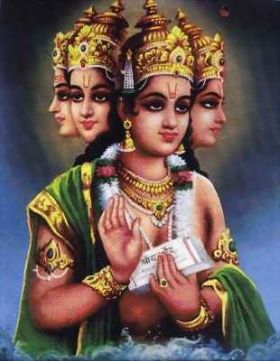 In section III we will attempt an overview of the various stories about Man’s origins. Before we begin, though, let’s summarize what we have done so far in our quest to find Man’s beginning. We have looked at science’s best explanations for both the origin of Man and the origin of Life in general, and found its answers wanting on numerous grounds, chief and most disturbing among them, scientific grounds. We have seen how science has, in essence, established its own series of ever-changing (ergo, pragmatic) myths to account for our beginnings, and we have found so-called science’s tools to be inadequate for dating objects beyond even 10,000 years ago. We have established the different domains of theoretical and practical science, noting along the way that there is little difference between science theory and science fiction, or fantasy; should the vision manifest itself it becomes, and only then, science.
In section III we will attempt an overview of the various stories about Man’s origins. Before we begin, though, let’s summarize what we have done so far in our quest to find Man’s beginning. We have looked at science’s best explanations for both the origin of Man and the origin of Life in general, and found its answers wanting on numerous grounds, chief and most disturbing among them, scientific grounds. We have seen how science has, in essence, established its own series of ever-changing (ergo, pragmatic) myths to account for our beginnings, and we have found so-called science’s tools to be inadequate for dating objects beyond even 10,000 years ago. We have established the different domains of theoretical and practical science, noting along the way that there is little difference between science theory and science fiction, or fantasy; should the vision manifest itself it becomes, and only then, science.
We have also looked at some extra-scientific tales about the origin of Man, hoping that maybe religion and myth, literature and history might better tell us from whence Man has come. To this end we have dabbled a bit in the Biblical tales, and even somewhat delved into the stories from Mesopotamia, which, if they be accurate as translated, would most certainly give us the source of the Creation stories in Genesis.
We cannot, though, in good conscience, say we yet know Man’s beginning.
I had to make a decision regarding the form of presentation for the chapters of this section. On one hand we ought to go by creed, arranged by number of adherents, on another by geography, still another by peoples and cultures. In any case we are talking about many different stories and legends. If we choose to go by creeds, or religions past and present, we are limited to the religions we have been able to discern, but this seems to me a smaller effort than trying to determine each civilization and culture.
Since we have also been going down the religious line, it would seem not only more expedient, but consistent, to continue to follow this track. The problem, though, is that the actual number of different religious systems, from all known history, is still very large, a complete analysis of them a Herculean labor. I have therefore divided section III into three parts, the East meaning everything east of the Caspian Sea, the West meaning everything from the western shores of the Caspian Sea to the Strait of Gibraltar, and the Americas for what is sometimes called, perhaps mistakenly, the New World. This will enable us to get at least a cursory global look at the variety of approaches Man has offered for answering for the problem of Man’s origin. While we must mention the uniqueness of each creed, we must keep a steady eye out for commonalities, as either might supply the answer to our question.
Now in the East we have several important major religions that have been around for quite some time. First to discuss is Hinduism, its Vedas among the oldest written literature, at least 3,000 years old. Hinduism is a pantheistic religion, meaning, in some sense at least, everything is God. The Hindu pantheon of gods is immense, very regional, and has changed through time. Primarily, the main god is a tripartite god featuring the Brahma-Vishnu-Shiva collaboration. But there can be as many gods as there are creatures on the Earth.
In practice the devout Hindu is usually very reserved and calm, a marked characteristic of those who are from the East and/or practice Eastern religion. The sincere Hindu of any patron deity is to be admired in many ways, and nearly every version of this religion breeds an inclusive-minded respect for others. Certainly it has its share of sinners, but mindful Hindus have, to a much greater extent and higher degree than most, a touch of special gentleness and humility that is a product of their religion and its culture. The Christian “Golden Rule” is present here, as in every religion, but perhaps nowhere exhibited as often as by the Hindu. For such a believer, you must treat everyone not merely as you would treat yourself or your brother, but rather, you must treat each person as a god. As with most religions, the soul or essential human spirit is god-like in nature, and so therefore is its possessor. Being as everyone has such a soul, or atman, it is by this common nature that all Men may be said to be divine.
Reincarnation is a big part of just about all of Hinduism’s many variations. This may, I think and despite some who would object, be considered the same as “transmigration of the soul”, a theory which maintains that after death the soul remains intact and vibrant. By good or bad karmic deeds the soul, this Hindi atman, after death and through a natural process, returns to Earth as another human being, an animal, maybe even a plant or stone depending on the type of life led prior. The goal is to eventually break the chain, to progress morally and ethically, rid one’s self of all accumulated karma enough to leave the cycle of Earthly incarnations and ascend to higher posts in the maintenance of the universe. Just as the very prospect of living means sinning to the Christian, living for the Hindu means acquiring karmas, good and bad, which must be balanced in the next life. Whereas the Christian creed, I think it fair to say, allows for a final death and destruction of a soul, for the Hindu all souls recur eternally either until they are ready to progress, or until by their own merits achieve a literally higher station in Life.
Not surprising there are several Hindu tales regarding the Creation of Man. From the Brithadaranyaka Upanishad, Max Mueller’s translation, we read:
In the beginning was Self [Atman] alone, in the shape of a person. He, looking round, saw nothing but his Self. He first said, “This is I”; therefore he became “I” by name. Therefore even now, if a man is asked, he first says, “This is I” and then pronounces the other name which he may have. And because before all this he (the Self) burnt down all evils, therefore he was a person [purusha]. Verily he who knows this burns down everyone who tries to be before him. He feared, and therefore anyone who is lonely fears. He thought, “As there is nothing but myself, why should I fear?” Then his fear passed away. For what should he have feared? Verily fear arises from a second only. But he felt no delight. Therefore a man who is lonely feels no delight. He wished for a second. He was as large as man and wife together. He then made this, his Self, to fall in two and thence arose husband (pat) and wife (patni). Therefore Yagnavalkya said, “We two are thus (each of us) like half a shell.” Therefore the void which was there is filled by the wife. He embraced her and men were born. She thought, “How can he embrace me after having produced me from himself? I shall hide myself.” She then became a cow, the other became a bull and embraced her, and hence cows were born. The one became a mare, and the other a stallion, the one a male ass, and the other a female ass. He embraced her, and hence one-hoofed animals were born. The one became a she-goat the other a he-goat; the one became a ewe, the other a ram. He embraced her, and hence goats and sheep were born. And thus he created everything that exists in pairs, down to the ants.
This story is very interesting because it calls to mind the fable told by Aristophanes in Plato’s Symposium, wherein Aristophanes and several other interlocutors debate the origin of the Sexes. Aristophanes related an allegory that humans were once androgynous, both male and female, like eggs, and then became separated, to forever seek their other halves. More on Plato in later chapters. In Hinduism also there is another, similar tale found in the Rig Veda:
The Man (Purusha) has a thousand heads, a thousand eyes, a thousand feet. He pervades the earth everywhere and extends beyond for ten fingers’ breadth. The Man himself is all this, whatever has been and whatever is to be. He is the lord of immortality and also lord of that which grows on food. Such is his greatness, and the Man is yet greater than this. All creatures make up a quarter of him; three quarters are the immortal in heaven. With three quarters the Man has risen above, and one quarter of him still remains here, whence he spread out everywhere, pervading that which eats and that which does not eat. From him Virj was born, and from Virj came the Man, who, having been born, ranged beyond the earth before and behind. When the gods spread the sacrifice, using the Man as the offering, spring was the clarified butter, summer the fuel, autumn the oblation. They anointed the Man, the sacrifice, born at the beginning, upon the sacred grass. With him the gods, Sdhyas, and sages sacrificed. From that sacrifice in which everything was offered, the clarified butter was obtained, and they made it into those beasts who live in the air, in the forest, and in villages. From that sacrifice in which everything was offered, the verses and the chants were born, the metres were born, and the formulas were born. From it horses were born, and those other animals which have a double set of incisors; cows were born from it, and goats and sheep were born from it.
When they divided the Man, into how many parts did they disperse him? What became of his mouth, what of his arms, what were his two thighs and his two feet called? His mouth was the brahmin, his arms were made into the nobles, his two thighs were the populace, and from his feet the servants were born. The moon was born from his mind; the sun was born from his eye. From his mouth came Indra and Agni, and from his vital breath the wind (Vyu) was born. From his navel the atmosphere was born; from his head the heaven appeared. From his two feet came the earth, and the regions of the sky from his ear. Thus they fashioned the worlds. There were seven, enclosing fire-sticks for him, and thrice seven fire-sticks when the gods, spreading the sacrifice, bound down the Man as the sacrificial beast. With this sacrifice the gods sacrificed; these were the first dharmas. And these powers reached the dome of heaven where dwell the ancient Sdhyas and gods. [Rig Veda 10.9]
According to this Sanskrit tradition, the entire universe is depicted as one huge organism, one huge single being, containing within itself the numerous other existing things, and so worlds within worlds all inside one giant entity which is the eminence of the Creator, Prajapati. According to Swami Krishnananda:
This is the universal Self, the Virat; his head is the shining region of the heavens; his eyes are the sun and the moon; his ears are the quarters of space, his speech is the Veda full of knowledge; his vital energy is the universal air; the whole universe is his heart; his feet are the lowest earth. [from his translation of the Mundaka Upanishad]
The Sanskrit from which this Veda comes is some of the oldest we know, 4,000 years of age not an indefensible date. Much later come the Ramayana, Mahabharata, and the Satapatha Brahmana, all of which can be attributed to around 500-300 BC. From the latter’s Eighth Adhyaya, First Brahmana, known as the IDÂ, and recounting actually an old Vedic tale, is the following flood story, important because of its discussions about Manu, or Manua, historically the first Man, and whose name literally means “Man”. The following citation begins at 1:8:1-1:
In the morning they brought to Manu water for washing, just as now also they bring [water] for washing the hands. When he was washing himself, a fish came into his hands. It spake to him the word, ‘Rear me, I will save thee!’ Wherefrom wilt thou save me? A flood will carry away all these creatures from that I will save thee! How am I to rear thee?’
It said, ‘As long as we are small, there is great destruction for us: fish devours fish. Thou wilt first keep me in a jar. When I outgrow that, thou wilt dig a pit and keep me in it. When I outgrow that, thou wilt take me down to the sea, for then I shall be beyond destruction.’
It soon became a ghasha [a large fish]; for that grows largest [of all fish]. Thereupon it said, ‘In such and such a year that flood will come. Thou shalt then attend to me by preparing a ship; and when the flood has risen thou shalt enter into the ship, and I will save thee from it.’
After he had reared it in this way, he took it down to the sea. And in the same year which the fish had indicated to him, he attended to the fish by preparing a ship; and when the flood had risen, he entered into the ship. The fish then swam up to him, and to its horn he tied the rope of the ship, and by that means he passed swiftly up to yonder northern mountain. It then said, ‘I have saved thee. Fasten the ship to a tree; but let not the water cut thee off, whilst thou art on the mountain. As the water subsides, thou mayest gradually descend!’ Accordingly he gradually descended, and hence that [slope] of the northern mountain is called ‘Alarm’s descent’. The flood then swept away all these creatures, and Manu alone remained here…
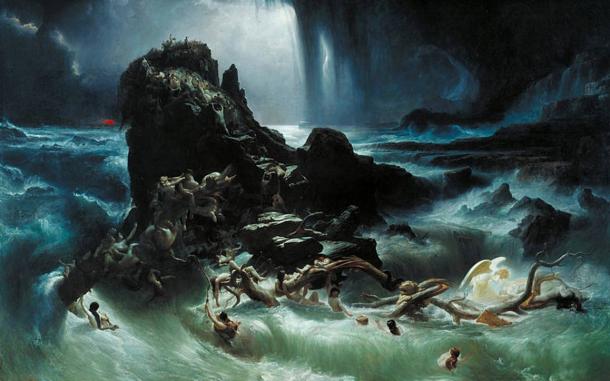
…(1:8:1:77…) Being desirous of offspring, he engaged in worshiping and austerities. During this time he also performed a pâka-sacrifice: he offered up in the waters clarified butter, sour milk, whey, and curds. Thence a woman was produced in a year: becoming quite solid she rose; clarified butter gathered in her footprint. Mitra and Varuna met her. They said to her, ‘Who art thou?’ ‘Manu’s daughter,’ she replied. ‘Say [thou art] ours,’ they said. ‘No,’ she said, ‘I am [the daughter] of him who begat me.’ They desired to have a share in her. She neither agreed nor disagreed, but passed by them. She came to Manu.
Manu said to her, ‘Who art thou?’ ‘Thy daughter,’ she replied. ‘How, illustrious one, [art thou] my daughter?’ he asked. She replied, ‘Those offerings (of) clarified butter, sour milk, whey, and curds, which thou madest in the waters, with them thou hast begotten me. I am the blessing: make use of me at the sacrifice! If thou wilt make use of me at the sacrifice, thou wilt become rich in offspring and cattle. Whatever blessing thou shalt invoke through me, all that shall be granted to thee!’ He accordingly made use of her (as the benediction) in the middle of the sacrifice; for what is intermediate between the fore-offerings and the after-offerings, is the middle of the sacrifice. With her he went on worshiping and performing austerities, wishing for offspring. Through her he generated this race, which is this race of Manu; and whatever blessing he invoked through her, all that was granted to him.
Now this [daughter of Manu] is essentially the same as the Idâ [Hindu goddess of the earth, abundant food, and nourishment. She is also the granter of any blessings evoked through her]; and whosoever, knowing this, performs with Idâ, he propagates this race which Manu generated; and whatever blessing he invokes through it, all that is granted to him…
As in the Christian tradition Manu is a flood survivor. In this rendition Man is the progeny of Manu and his union with a creation of the gods, and so one could argue that Man after the flood is, for Hinduism, a product of Original Man and Original Woman. I believe Helena Blavatsky was the first to recognize the Adam and Eve “first couple” idea in the Hindu texts, particularly the Upanishads, as in the Mundakopanishad, or the Mundaka Upanishad (great .pdf file thanks to Swami Krishnananda). There is also found the following myth, alluded to earlier. It forms the basis of the trimurti creation story:
Before the beginning, the Brahman (absolute reality) was one and non-dual. It thought, ‘I am only one — may I become many.’ This caused a vibration which eventually became sound, and this sound was Om. Creation itself was set in motion by the vibration of Om. The closest approach to Brahman is that first sound, Om. Thus, this sacred symbol has become emblematic of Brahman just as images are emblematic of material objects.The vibration produced by chanting Om in the physical universe corresponds to the original vibration that first arose at the time of creation. [source]
Of course there is also the tale about Vishnu asleep on the ocean floor, protected by the coiled serpent, who along with Shiva and Brahma descended to Earth.
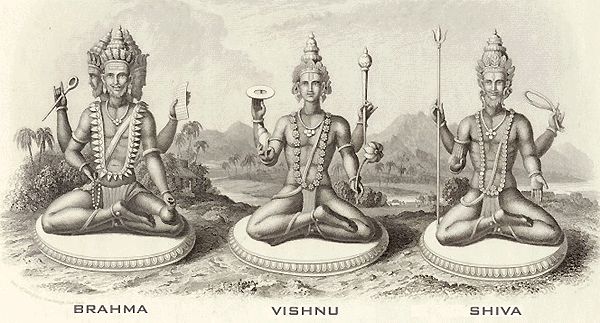
When it comes to the creation of the universe in general the great sages of Hinduism and the Rig Veda have this to say:
In the beginning there was neither existence nor non- existence; there was no atmosphere, no sky, and no realm beyond the sky. What power was there? Where was that power? Who was that power? Was it finite or infinite?
There was neither death nor immortality. There was nothing to distinguish night from day. There was no wind or breath. God alone breathed by his own energy. Other than God there was nothing.
In the beginning darkness was swathed in darkness. All was liquid and formless. God was clothed in emptiness.
Then fire arose within God; and in the fire arose love. This was the seed of the soul. Sages have found this seed within their hearts; they have discovered that it is the bond between existence and non-existence.
Who really knows what happened? Who can describe it? How were things produced? Where was creation born? When the universe was created, the one became many. Who knows how this occurred? Did creation happen at God’s command, or did it happen without his command? He looks down upon creation from the highest heaven. Only he knows the answer – or perhaps he does not know. [Rig Veda 10:129.1-7]
Indeed perhaps he does not know. For in Hinduism it is, as can be argued for many religions, highly possible that our Creator is an underling, a subsidiary, perhaps even a common workman for the Designer of Designers of the universe. This would make for an interesting proposition. For if our ultimate Creator leaves our birth, rearing, death, and, perhaps, rebirth, to others, by some division of labor perhaps, to whom do we owe our heartfelt gratitude, or our ire for our fate? Is it our birth father who is responsible for what we are and can be, or is it the one who raises us that makes us what we become?
So I will leave you with one more question to ponder. Is something better, or even different than nothing? Keep that in mind, especially considering Buddhism is next.


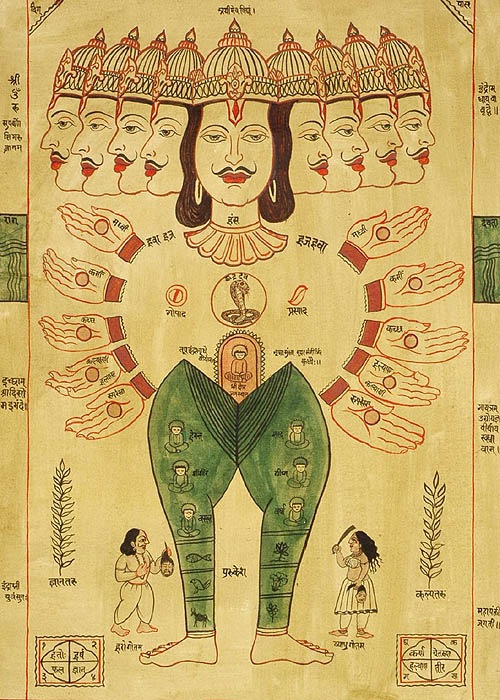
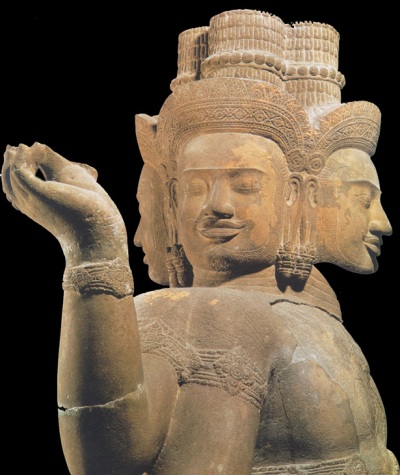
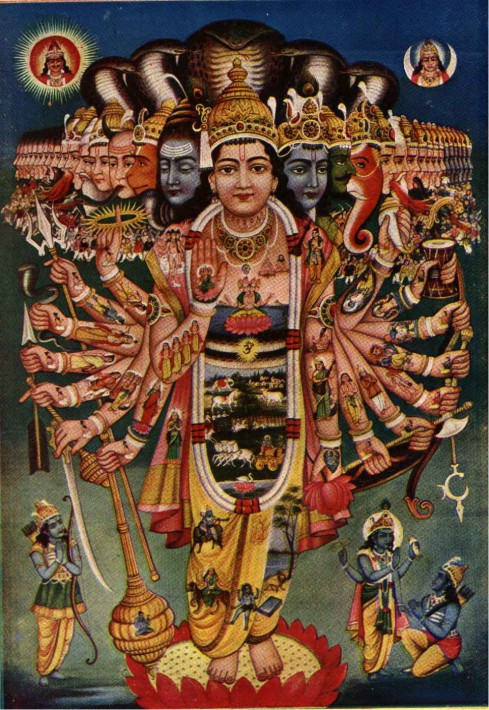





Neil Kiriella
October 20, 2010 at 9:33 am
I learn a lot from you. I am researcher making an effort to prove the Historicity of Ramayana & Rawana. I am the author of Ramayana & Historical Rawana which had lots of criticisms from the Royal Asiatic Society of Sri Lanka.
truthopia
October 21, 2010 at 9:11 pm
Thanks, I hope this is all of further use to you.
AC
Joakim
January 31, 2022 at 2:28 pm
O have an old image of a Tirthankara. Can you help me identify him. It may be purushkara.